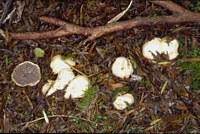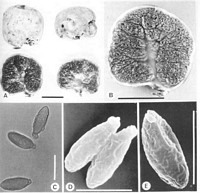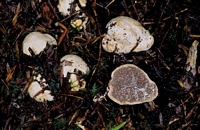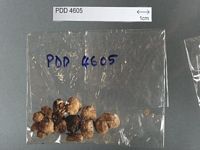|
 Hysterangium rugisporum Hysterangium rugisporum
BiostatusPresent in region - Indigenous. Endemic
Images (click to enlarge)
Owner: R.E. Beever | 
Caption: Fig. 6 Hysterangium rugisporum. A, Basidiomata exterior and in section (PDD 62455).
B, Basidioma in section (PDD 62455). C, Basidiospores by bright field (PDD 4605). D, E,
Basidiospores by SEM (PDD 4605). Scale: 1 cm (A, B), 10 Vin (C, D, E). | 
Caption: REB 1346
Owner: Ross Beever | 
Caption: Dried type specimen
Owner: Herb PDD | 
Caption: Dried type specimen
Owner: Herb PDD | 
Caption: Dried type specimen
Owner: Herb PDD |
Article: Castellano, M.A.; Beever, R.E. (1994). Truffle-like Basidiomycotina of New Zealand: Gallacea, Hysterangium, Phallobata, and Protubera. New Zealand Journal of Botany 32(3): 305-328 (http://www.rsnz.org/publish/abstracts.php).
Description: Basidiomata up to 3 cm diam., subglobose to irregularly lobed with an indented base,
white when fresh, bruising brown, mottled yellowish brown, white to brown when dry,
surface with a fine pubescence which is easily rubbed off on handling, sometimes with
adhering soil particles; EtOH mid brown. Gleba brownish grey when fresh drying to
greyish olive to olive; locules irregular to elongate, more or less radially arranged, empty.
Rhizomorph single, becoming branched several millimetres from point of attachment,
up to 0.5 mm diam., attached at base, concolorous with peridium. Columella dendroid,
with up to 6 primary branches in longitudinal section, gelatinous, translucent to opaque
near base, stout, arising from a sterile base, nearly black when dry. Taste slightly
peppery. Odour musty to faintly acidic. Peridium peeling readily in large flakes, up to
800 µm thick, 3-layered; epicutis 80-300 dim thick, of hyaline, thin-walled, compactly
interwoven, bead-like hyphae, which are elongate to subglobose, 2-5(-8) µm diam.,
associated with droplets of oil which become minute crystalline incrustations on storage,
clamp connections absent; mesocutis 200-400 µm thick, of hyaline, thin-walled,
compact, irregularly inflated, subglobose to polyhedral hyphae up to 20 µm diam., clamp
connections absent; subcutis 60-80(-100) µm thick, of golden brown isodiametric cells
which collapse and then appear as more or less periclinal hyphae, clamp connections
absent. Trama 100-300 µm thick, of hyaline, compactly interwoven hyphae, 1-2 µm
diam., in a gelatinised matrix, clamp connections absent. Basidia hyaline, cylindric with
narrowed base, 35-55 x 9-10 µm long, 4-6-spored. Spores minutely verrucose (by light
microscopy), 12-17 x 5-6 µm, broadly ellipsoid, apex obtuse, base with a short sterigmal
attachment; wall c. 0.5 µm thick. Utricle distinct, 1 µm thick, wrinkled, usually adhering
to spore wall. Spore colour in KOH pale green singly, greenish brown in mass.
Habitat: Habitat: hypogeous to partially epigeous in modified forest, putatively mycorrhizal with
Leptospermum scoparium and L. ericoides. Season: April through October.
Distribution: New Zealand.
Notes: ETYMOLOGY: From Latin ruga, wrinkle, and spora, spore, referring to the wrinkled
utricle surrounding the spores.
REMARKS: Hysterangium rugisporum differs from H. youngii in its smaller spores, and
from H. neotunicatum in its regularly verrucose spores, and brown reaction with EtOH
and to bruising.
|